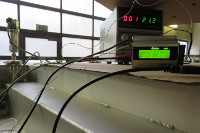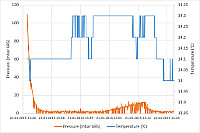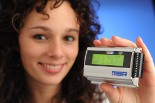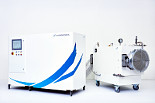Recording measured data: Logging vacuum data
MSR255 Data Logger helps identify leakages in vacuum chambers
Authors: Nic Piatkowski, PhD, Climeworks AG, Gabriela Zumkehr, MSR Electronics GmbH
Mini data loggers are proving to be useful tools for recording and storing physical measurands in diverse fields of industry and science. As the present user report concerning MSR data loggers at Climeworks AG – an internationally recognised developer of CO2 collectors – shows, these small data recording devices are able to do much more than has been known to date with respect to their typical applications, such as monitoring transport conditions.
Whilst CO2 has fallen into disrepute as a climate killer, it does not only have drawbacks. This gas is, for example, used as a protective atmosphere when packaging food and helps accelerate the growth of plants. With the innovative technologies of Zurich-based Climeworks AG, a spinoff of ETH Zurich, the gas is produced virtually CO2-neutral, using waste heat. With the CO2 collector, Climeworks has developed a technical solution that extracts highly concentrated CO2 from air with a low expenditure of energy. This “renewable” CO2 is the ideal raw material for many industrial applications, including synthetic automotive fuels such as Diesel, petrol and methane. The car manufacturer Audi, for instance, has also recognised the benefit of these CO2 collectors; it plans to integrate and test the world’s first industrial module of a CO2 collector in a synthetic fuel production plant.
What do the CO2 collectors do?
The Climeworks process is based on the cyclical adsorption and desorption of CO2 from ambient air. During the adsorption process, ambient air passes through a specially developed adsorber system, which contains a sorbent that binds the CO2. As soon as the sorbent is saturated with CO2, the process is switched to the desorption phase in which the sorbent releases the isolated CO2. For this purpose, it his heated to approx. 80-130 °C by means of low-temperature heat and exposed to a rough vacuum in a vacuum chamber. The company had such a vacuum chamber constructed for a new product line and tested it with respect to leakages and structural strength using a mini data logger.
MSR255 Data Logger monitors vacuum
 Climeworks selected a data logger of the type MSR255 by the Swiss measurement technology company MSR Electronics GmbH for the acceptance tests of the vacuum chamber. This compact miniature measurement technology laboratory has a large memory (2 million measured values) and an LC display that can be individually configured; it is ideal for flexible, on-site measurements – even under special ambient conditions. In its full version, this data logger is able to record up to five different measurands at the same time and to store their values. However, at Climeworks the MSR255 was used with an external temperature sensor and analogue inputs for connecting Climeworks’ own pressure sensor, which was placed inside the vacuum chamber. With the logger, the company was able to provide accurate information regarding the pressure ratios and pressure patterns for each time unit and, in particular, observe a pressure loss caused by a leakage.
Climeworks selected a data logger of the type MSR255 by the Swiss measurement technology company MSR Electronics GmbH for the acceptance tests of the vacuum chamber. This compact miniature measurement technology laboratory has a large memory (2 million measured values) and an LC display that can be individually configured; it is ideal for flexible, on-site measurements – even under special ambient conditions. In its full version, this data logger is able to record up to five different measurands at the same time and to store their values. However, at Climeworks the MSR255 was used with an external temperature sensor and analogue inputs for connecting Climeworks’ own pressure sensor, which was placed inside the vacuum chamber. With the logger, the company was able to provide accurate information regarding the pressure ratios and pressure patterns for each time unit and, in particular, observe a pressure loss caused by a leakage.
Leakages are quickly identified
For the acceptance test, at the manufacturer’s premises, the pressure within the vacuum chamber was reduced to approximately 1 mbar absolute. Temperature and pressure values were monitored throughout, to check the quality of the seal. The pressure was measured with a 2-wire/24 V pressure sensor with 4...20 mA output for a pressure of 0-1 bar absolute.
 It was powered by a laboratory power supply and connected with the 4...20 mA analogue input port of the MSR255 data logger. The logger was programmed so that the 4...20 mA signal was rescaled directly into an output value of 0-1 bar (absolute). The temperature of the vacuum chamber was measured with the integrated temperature sensor of the MSR255, which had been attached to the wall of the vacuum chamber. The measured values are analysed by means of the MSR PC software, which delivers very meaningful measurement diagrams. The developments of the temperature and pressure values evident from this, as well as the known volume of the vacuum chamber, were used to determine the increase of the air mass in the chamber via the ideal gas law and thus the leakage rate was calculated. This practical example already shows that the miniature data loggers can be used profitably in versatile metrological application scenarios, saving both time and costs – the spectrum of applications ranges from logistics, through machine and transportation monitoring, to laboratory measurement technology, automotive test bench technology and even aerospace.
It was powered by a laboratory power supply and connected with the 4...20 mA analogue input port of the MSR255 data logger. The logger was programmed so that the 4...20 mA signal was rescaled directly into an output value of 0-1 bar (absolute). The temperature of the vacuum chamber was measured with the integrated temperature sensor of the MSR255, which had been attached to the wall of the vacuum chamber. The measured values are analysed by means of the MSR PC software, which delivers very meaningful measurement diagrams. The developments of the temperature and pressure values evident from this, as well as the known volume of the vacuum chamber, were used to determine the increase of the air mass in the chamber via the ideal gas law and thus the leakage rate was calculated. This practical example already shows that the miniature data loggers can be used profitably in versatile metrological application scenarios, saving both time and costs – the spectrum of applications ranges from logistics, through machine and transportation monitoring, to laboratory measurement technology, automotive test bench technology and even aerospace.
Can we also help you with your measuring tasks? We would be pleased to advise you!
 Deutsch
Deutsch


